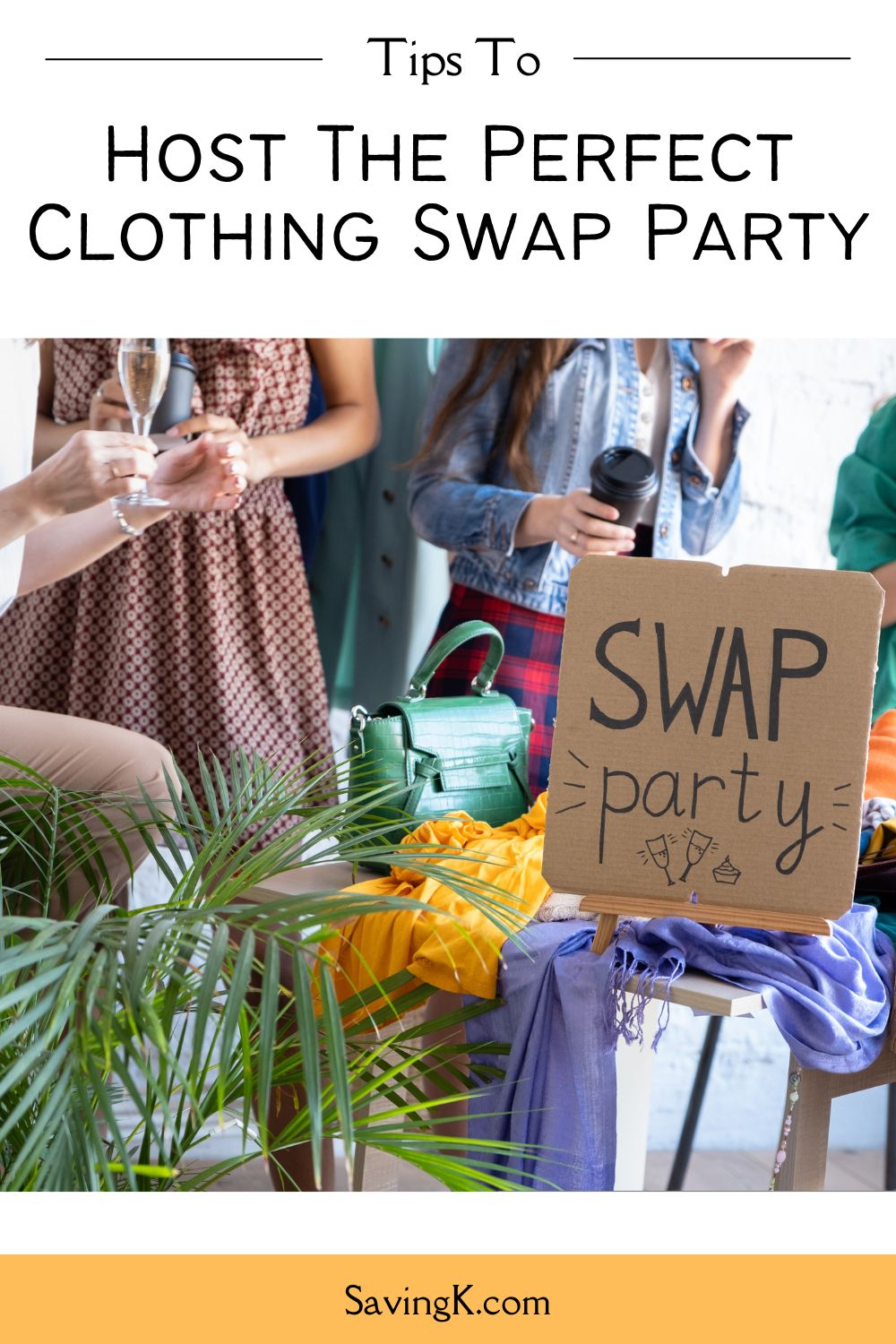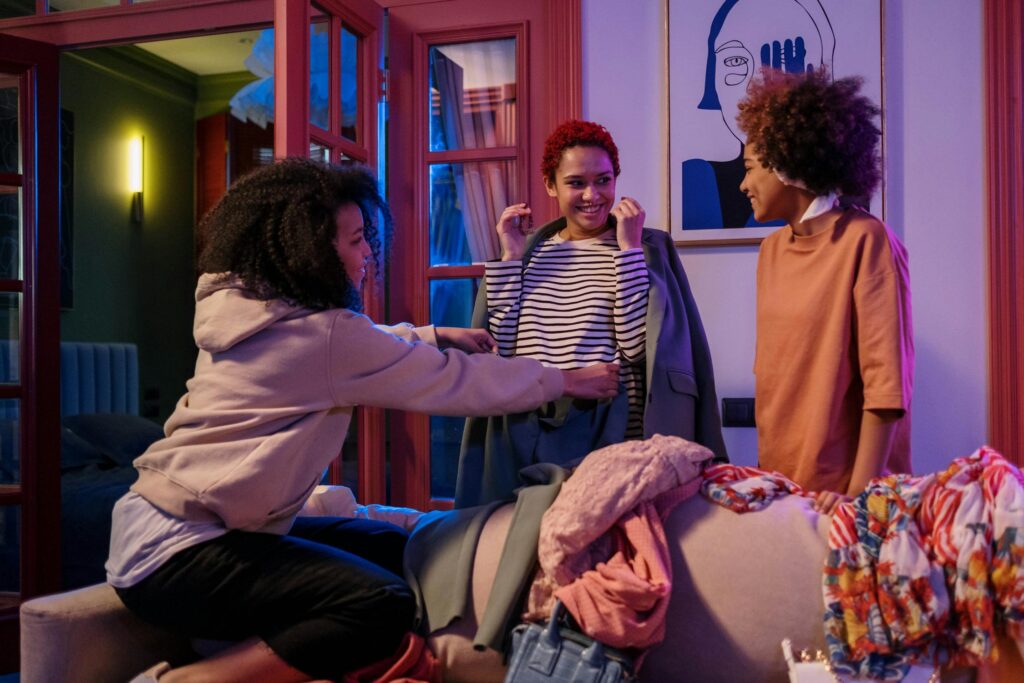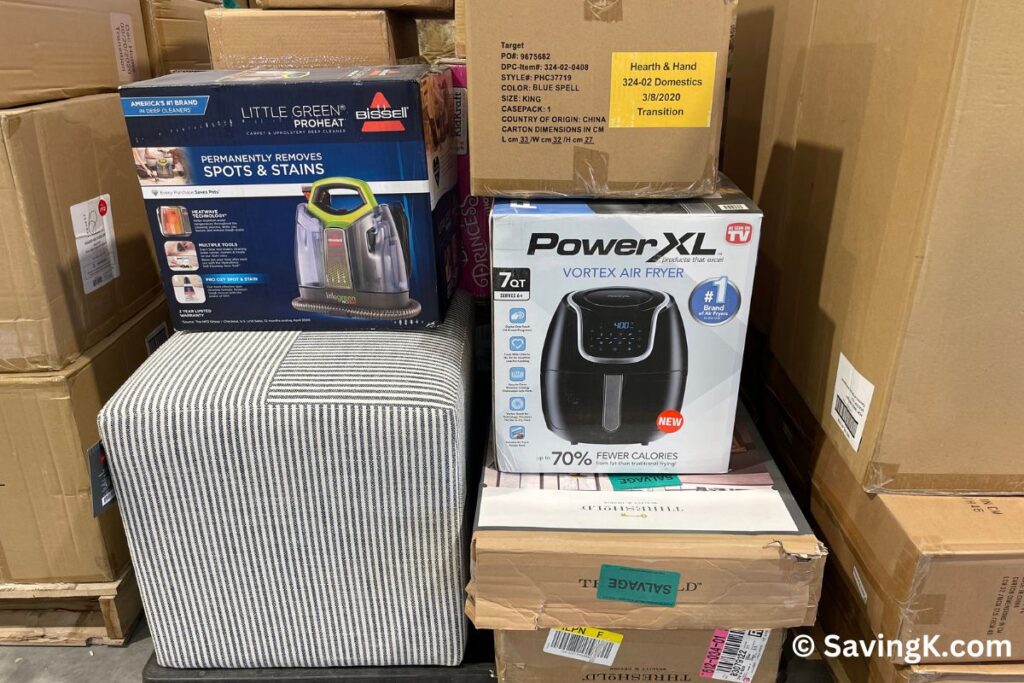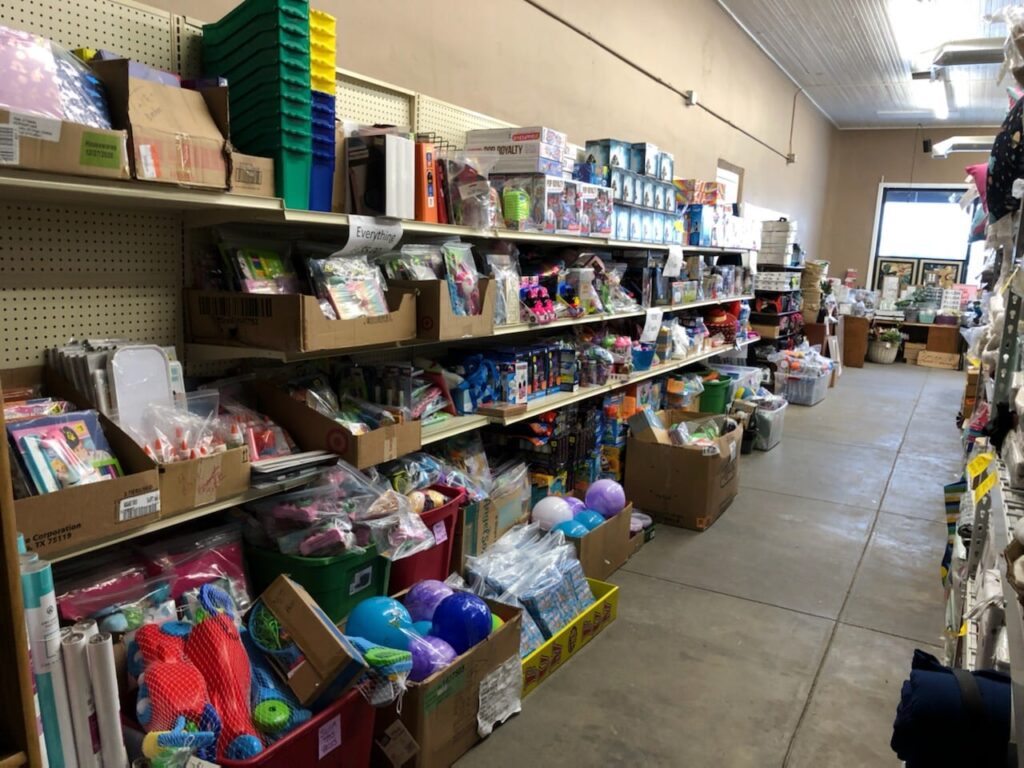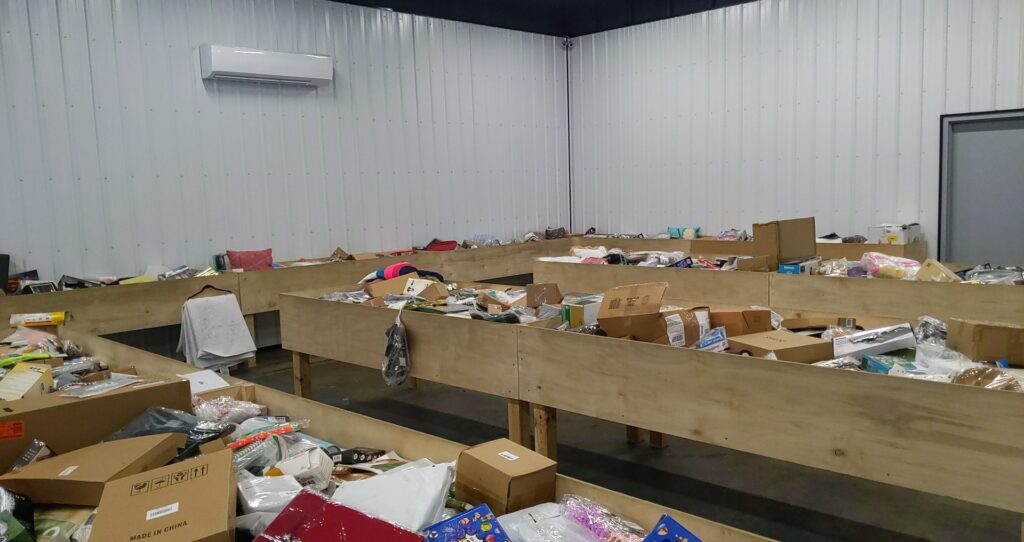
Did you know the average American throws away about 81 pounds of clothing each year? Enter the clothing swap party – a brilliant solution that’s transforming how we refresh our wardrobes while fighting fast fashion waste. Think of it as a treasure hunt meets social gathering, where one person’s forgotten fashion finds become another’s style statement.
What started as small gatherings among friends has evolved into organized events that combine sustainability with social connection. From themed exchanges to token-based systems, today’s clothing swap parties offer a sophisticated approach to sustainable fashion that’s catching on everywhere from neighborhood communities to corporate offices.

Contents
- 1. Themed Clothing Swaps
- 2. Quality Over Quantity Rule
- 3. Token-Based System
- 4. Group and Timeslot System
- 5. Inclusive Options for All Sizes and Styles
- 6. Organized Setup and Merchandising
- 7. Icebreakers and Social Activities
- 8. Refreshments and Ambiance
- 9. Post-Event Cleanup and Donation
- 10. Environmental and Budget-Friendly Benefits
1. Themed Clothing Swaps
Want to make your clothing swap party more exciting? Choosing a specific theme can transform your event from a simple exchange into a memorable clothing exchange. Summer season swaps are perfect for sundresses and beachwear, while winter-themed events focus on cozy sweaters and warm accessories. For working professionals, a work attire swap helps refresh office wardrobes with blazers and dress pants.
Parents love themed swaps focusing on maternity wear or kids’ clothing, making it easier to keep up with growing families. Holiday-themed exchanges, featuring Halloween costumes or ugly Christmas sweaters, add a festive twist. For those special occasions, formal wear swaps help everyone find the perfect outfit without breaking the bank.
You can even expand beyond clothing with accessories or multi-item swaps that include books, DVDs, and games for added variety.
2. Quality Over Quantity Rule
A successful clothing swap party hinges on one crucial principle: quality over quantity. Encourage guests to bring well-made pieces that still have life in them rather than loads of worn-out items. Set clear guidelines about acceptable condition – clothes should be clean, free from stains or tears, and maintain their original shape. Look for quality materials like wool, cotton, or cashmere that will benefit their new owners for years to come.
When sending invitations, specify that all garments should be gently used and ready to wear. Consider implementing a screening process where items are checked at the door. This ensures everyone gets value from the exchange and promotes sustainable fashion. Remember, it’s better to have ten quality pieces than fifty items that’ll end up back in the donation pile.
3. Token-Based System
Keep your clothing swap fair and organized with a simple token system. When guests arrive, they receive tokens based on their contributions – typically one to three tokens per item depending on quality. High-end pieces like dresses and jackets earn three tokens, mid-range items like blouses get two tokens, and basic pieces like t-shirts receive one token.
Color-coding makes the process even smoother – try using different colored tokens for each value tier. For instance, green tokens for premium items, yellow for mid-range, and blue for basics. Display clear signage showing token values and attach small tags to each item to indicate their token cost. This system ensures everyone gets equal value from their swaps and prevents any single person from claiming all the best pieces.
When distributing tokens, consider setting item limits to maintain quality standards and keep the exchange manageable. Track exchanges using simple cards where participants can record their token balance.
4. Group and Timeslot System
To keep your clothing swap organized and enjoyable, implement a structured timeslot system. Divide attendees into small groups of 4-6 people, assigning each group a specific 15-20 minute browsing window. This prevents overcrowding around clothing racks and ensures fair exchange of items.
Create a schedule that rotates groups through different sections – for example, Group A starts with dresses while Group B browses tops. Use colored wristbands to identify group members and post clear signage showing when each group can access different areas. Between rotations, allow a quick 5-minute buffer for restocking and reorganizing rails.
Consider giving early access slots to volunteers who help set up the event. Keep things moving smoothly by having a designated timekeeper who announces rotation times. This systematic approach helps prevent the common chaos of everyone rushing for the same items simultaneously.
5. Inclusive Options for All Sizes and Styles
Create a welcoming atmosphere by organizing your clothing swap to accommodate all body types and fashion preferences. Set up dedicated sections for extended sizes ranging from XS to 5XL, clearly labeled to help participants find their size ranges quickly. Include a diverse mix of styles – from casual wear to professional attire – to ensure everyone finds pieces that match their taste.
Don’t limit the swap to just clothing. Include accessories like scarves, jewelry, and handbags that fit any size. Set up a separate station for shoes in various widths and sizes, and consider adding a section for beauty products and cosmetics. This variety helps ensure that even if someone doesn’t find clothing in their size, they can still participate meaningfully in the exchange.
For maximum inclusivity, encourage participants to bring adaptive clothing options and provide detailed descriptions of items’ features, such as closure types or fabric content. Remember to arrange items at different heights to make browsing accessible for everyone.
6. Organized Setup and Merchandising
A well-organized setup transforms your clothing swap into a boutique-like experience. Start by arranging sturdy clothing racks and tables around the perimeter of your space, leaving ample room for browsing. Create distinct zones for different categories – tops, bottoms, dresses, and accessories – with clear signage overhead or on stands.
Display items professionally using matching hangers to create a cohesive look. Position full-length mirrors strategically throughout the space, and ensure good lighting for accurate color representation. Set up folding stations with tables for sweaters and jeans, complete with size dividers for easy navigation.
Consider creating a dedicated trying-on area with portable garment racks and a few chairs. Label each section clearly with size ranges and categories, using color-coded tags or signs. Set up clear zones for accessories table with jewelry displays, shoe racks, and handbag stands to showcase these items effectively.
7. Icebreakers and Social Activities
Turn your clothing swap into a vibrant social gathering by incorporating engaging activities throughout the event. Set up a “story station” where guests can share stories about items – like that designer find from a Paris boutique or a vintage piece with family history. Create conversation corners with comfortable seating where small groups can chat while sipping refreshments.
Consider organizing local artisan panels led by fashion enthusiasts, or sustainability experts. These could include quick sewing tutorials, tips on upcycling clothes, or discussions about ethical fashion. Screen short documentary clips about sustainable fashion to spark meaningful conversations.
For added fun, organize a fashion show where participants model their new finds, complete with a makeshift runway and playful commentary. Create a photo booth area with props and encourage guests to encourage guest mingling on social media using a unique event hashtag. Remember to collect contact information for a private group where attendees can continue building relationships and planning future swaps.
8. Refreshments and Ambiance
Create an inviting atmosphere at your clothing swap party with thoughtfully planned refreshments and ambiance. Set up a dedicated refreshment station with light snacks, wine, punch, and non-alcoholic beverages to keep guests energized and social. Cookies, finger foods, and easy-to-eat appetizers work best since participants will be busy browsing and trying on clothes.
Transform your space with strategic lighting – fairy lights and candles create a warm, boutique-like atmosphere that encourages guests to linger. Add colorful textiles as decorative elements to complement the clothing displays. Keep the energy upbeat with a carefully curated playlist that sets a festive mood without overwhelming conversation.
Arrange comfortable seating areas near the refreshments where guests can take breaks, socialize, and discuss their finds. These cozy conversation spots help foster a relaxed, enjoyable environment that turns your clothing swap from a simple exchange into a memorable social gathering.
9. Post-Event Cleanup and Donation
Once the clothing swap winds down, transform the cleanup into an organized effort that benefits your community. Start by sorting remaining items into clear categories – tops, bottoms, dresses, and accessories. Launder any items that need freshening up, ensuring each piece maintains its dignity for future recipients.
Partner with local nonprofits, shelters, or hospitals that accept clothing donations. Before delivering items, verify their acceptance criteria and prepare items accordingly. Create an inventory list of donations for tax purposes and organization records.
Express gratitude to attendees through personalized thank-you notes or emails, sharing the impact of their participation. Include details about where their unclaimed items will be donated, fostering a sense of continued community contribution. Set aside quality pieces for future swaps, storing them in clearly labeled bins to maintain organization.
Consider creating a digital record of successful donations to share with participants, encouraging ongoing involvement in sustainable fashion initiatives.
10. Environmental and Budget-Friendly Benefits
Clothing swaps offer a powerful solution to combat textile waste while helping participants refresh their wardrobes without spending money. By extending the life of existing garments, these events reduce the demand for new clothing production, which significantly decreases carbon emissions and water consumption associated with manufacturing. Each swapped item represents one less piece in landfills and reduces the environmental impact of fast fashion.
Beyond environmental benefits, swaps provide substantial financial savings. Instead of spending money on new clothes, participants exchange items they no longer want for fresh pieces that excite them. This circular approach to fashion not only saves hundreds of dollars annually but also builds meaningful connections within communities.
When promoting these benefits to potential guests, emphasize how each swapped item contributes to a more sustainable future. Share statistics about fashion’s environmental impact and calculate potential savings to demonstrate the tangible advantages of participating in clothing swaps over traditional shopping.
Making Fashion Sustainable, One Swap at a Time
Clothing swap parties represent more than just a trend – they’re a movement toward mindful consumption and community building. By combining social interaction with sustainable practices, these events create lasting impacts that extend far beyond updated wardrobes. They foster connections, promote environmental consciousness, and prove that style doesn’t have to come at the expense of sustainability.
As fast fashion continues to challenge our environment and wallets, clothing swap parties offer a practical, enjoyable solution. Whether you’re hosting your first swap or joining an established event, you’re participating in a revolution that’s making fashion more sustainable, accessible, and community-oriented.
